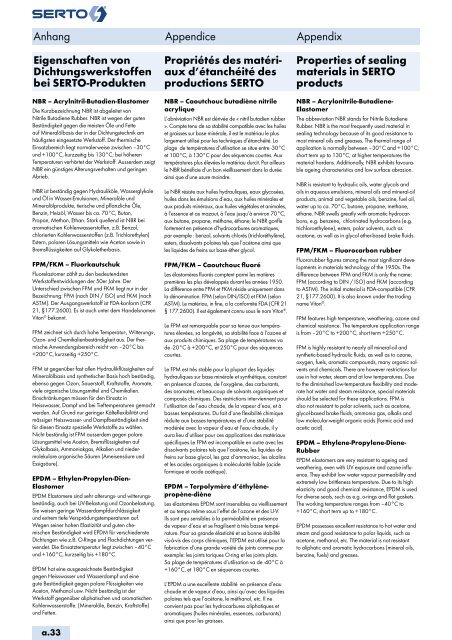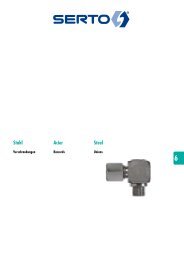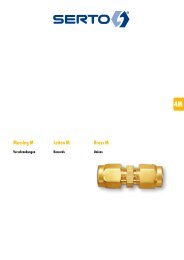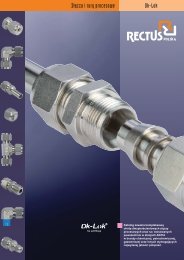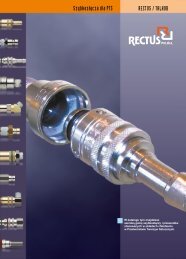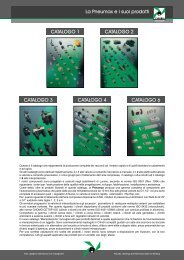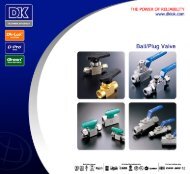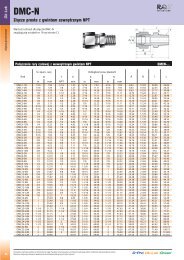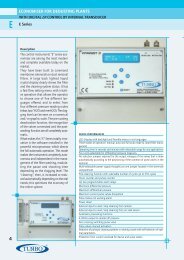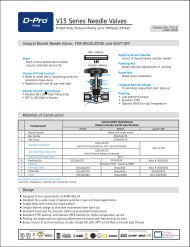You also want an ePaper? Increase the reach of your titles
YUMPU automatically turns print PDFs into web optimized ePapers that Google loves.
Anhang Appendice AppendixEigenschaften vonDichtungswerkstoffenbei SERTO-ProduktenNBR – Acrylnitril-Butadien-ElastomerDie Kurzbezeichnung NBR ist abgeleitet vonNitrile Butadiene Rubber. NBR ist wegen der gutenBeständigkeit gegen die meisten Öle und Fetteauf Mineralölbasis der in der Dichtungstechnik amhäufigsten eingesetzte Werkstoff. Der thermischeEinsatzbereich liegt normalerweise zwischen –30°Cund +100°C, kurzzeitig bis 130°C; bei höherenTemperaturen verhärtet der Werkstoff. Ausserdem zeigtNBR ein günstiges Alterungsverhalten und geringenAbrieb.NBR ist beständig gegen Hydrauliköle, Wasserglykoleund Öl in Wasser-Emulsionen, Mineralöle undMineralölprodukte, tierische und pflanzliche Öle,Benzin, Heizöl, Wasser bis ca. 70°C, Butan,Propan, Methan, Ethan. Stark quellend ist NBR beiaromatischen Kohlenwasserstoffen, z.B. Benzol,chlorierten Kohlenwasserstoffen (z.B. Trichlorethylen)Estern, polaren Lösungsmitteln wie Aceton sowie inBremsflüssigkeiten auf Glykoletherbasis.FPM/FKM – FluorkautschukFluorelastomer zählt zu den bedeutendstenWerkstoffentwicklungen der 50er Jahre. DerUnterschied zwischen FPM und FKM liegt nur in derBezeichnung: FPM (nach DIN / ISO) und FKM (nachASTM). Der Ausgangswerkstoff ist FDA-konform (CFR21, §177.2600). Es ist auch unter dem HandelsnamenViton ® bekannt.FPM zeichnet sich durch hohe Temperatur-, Witterungs-,Ozon- und Chemikalienbeständigkeit aus. Der thermischeAnwendungsbereich reicht von –20°C bis+200°C, kurzseitig +250°C.FPM ist gegenüber fast allen Hydraulikflüssigkeiten aufMineralölbasis und synthetischer Basis hoch beständig,ebenso gegen Ozon, Sauerstoff, Kraftstoffe, Aromate,viele organische Lösungsmittel und Chemikalien.Einschränkungen müssen für den Einsatz inHeisswasser, Dampf und bei Tieftemperaturen gemachtwerden. Auf Grund nur geringer Kälteflexibilität undmässiger Heisswasser- und Dampfbeständigkeit sindfür diesen Einsatz spezielle Werkstoffe zu wählen.Nicht beständig ist FPM ausserdem gegen polareLösungsmittel wie Aceton, Bremsflüssigkeiten aufGlykolbasis, Ammoniakgas, Alkalien und niedermolekulareorganische Säuren (Ameisensäure undEssigsäure).EPDM – Ethylen-Propylen-Dien-ElastomerEPDM Elastomere sind sehr alterungs- und witterungsbeständig,auch bei UV-Belastung und Ozonbelastung.Sie weisen geringe Wasserdampfdurchlässigkeitund extrem tiefe Versprödungstemperaturen auf.Wegen seiner hohen Elastizität und guten chemischenBeständigkeit wird EPDM für verschiedensteDichtungen wie z.B. O-Ringe und Flachdichtungen verwendet.Die Einsatztemperatur liegt zwischen –40°Cund +160°C, kurzseitig bis +180°C.EPDM hat eine ausgezeichnete Beständigkeitgegen Heisswasser und Wasserdampf und einegute Beständigkeit gegen polare Flüssigkeiten wieAceton, Methanol usw. Nicht beständig ist derWerkstoff gegenüber aliphatischen und aromatischenKohlenwasserstoffe. (Mineralöle, Benzin, Kraftstoffe)und Fetten.a.33Propriétés des matériauxd’étanchéité desproductions SERTONBR – Caoutchouc butadiène nitrileacryliqueL’abréviation NBR est dérivée de « nitril butadien rubber». Compte tenu de sa stabilité compatible avec les huileset graisses sur base minérale, il est le matériau le pluslargement utilisé pour les techniques d’étanchéité. Laplage de températures d’utilisation se situe entre -30°Cet 100°C, à 130°C pour des séquences courtes. Auxtempératures plus élevées le matériau durcit. Par ailleursle NBR bénéficie d’un bon vieillissement dans la duréeainsi que d’une usure moindre.Le NBR résiste aux huiles hydrauliques, eaux glycosées,huiles dans les émulsions d’eau, aux huiles minérales etaux produits minéraux, aux huiles végétales et animales,à l’essence et au mazout, à l’eau jusqu’à environ 70°C,aux butane, propane, méthane, éthane; le NBR gonflefortement en présence d’hydrocarbures aromatiques,par exemple : benzol, solvants chlorés (trichloréthylène),esters, dissolvants polaires tels que l’acétone ainsi queles liquides de freins sur base éther glycol.FPM/FKM – Caoutchouc fluoréLes élastomères fluorés comptent parmi les matièrespremières les plus développés durant les années 1950.La différence entre FPM et FKM réside uniquement dansla dénomination: FPM (selon DIN/ISO) et FKM (selonASTM). Le matériau, in fine, a la conformité FDA (CFR 21§ 177.2600). Il est également connu sous le nom Viton ® .Le FPM est remarquable pour sa tenue aux températuresélevées, sa longévité, sa stabilité face à l’ozone etaux produits chimiques. Sa plage de températures vade -20°C à +200°C, et 250°C pour des séquencescourtes.Le FPM est très stable pour la plupart des liquideshydrauliques sur base minérale et synthétique, constanten présence d’ozone, de l’oxygène, des carburants,des aromates, et beaucoup de solvants organiques etcomposés chimiques. Des restrictions interviennent pourl’utilisation de l’eau chaude, de la vapeur d’eau, et àbasses températures. Du fait d’une flexibilité chimiqueréduite aux basses températures et d’une stabilitémodérée avec la vapeur d’eau et l’eau chaude, il yaura lieu d’utiliser pour ces applications des matériauxspécifiques.Le FPM est incompatible en outre avec lesdissolvants polaires tels que l’acétone, les liquides defreins sur base glycol, les gaz d’ammoniac, les alcalinset les acides organiques à molécularité faible (acideformique et acide acétique).EPDM – Terpolymère d’éthylènepropène-dièneLes élastomères EPDM sont insensibles au vieillissementet au temps même sous l’effet de l’ozone et des U-V.Ils sont peu sensibles à la perméabilité en présencede vapeur d’eau et se fragilisent à très basse température.Pour sa grande élasticité et sa bonne stabilitévis-à-vis des corps chimiques, l’EPDM est utilisé pour lafabrication d’une grande variété de joints comme parexemple: les joints toriques O-ring et les joints plats.Sa plage de températures d’utilisation va de -40°C à+160°C, et 180°C en séquences courtes.L’EPDM a une excellente stabilité en présence d’eauchaude et de vapeur d’eau, ainsi qu’avec des liquidespolaires tels que l’acétone, le méthanol, etc. Il neconvient pas pour les hydrocarbures aliphatiques etaromatiques (huiles minérales, essences, carburants)ainsi que pour les graisses.Properties of sealingmaterials in SERTOproductsNBR – Acrylonitrile-Butadiene-ElastomerThe abbreviation NBR stands for Nitrile ButadieneRubber. NBR is the most frequently used material insealing technology because of its good resistance tomost mineral oils and greases. The thermal range ofapplication is normally between –30°C and +100°C,short term up to 130°C; at higher temperatures thematerial hardens. Additionally, NBR exhibits favourableageing characteristics and low surface abrasion.NBR is resistant to hydraulic oils, water glycols andoils in aqueous emulsions, mineral oils and mineral-oilproducts, animal and vegetable oils, benzine, fuel oil,water up to ca. 70°C, butane, propane, methane,ethane. NBR swells greatly with aromatic hydrocarbons,e.g. benzene, chlorinated hydrocarbons (e.g.trichloroethylene), esters, polar solvents, such asacetone, as well as in glycol ether-based brake fluids.FPM/FKM – Fluorocarbon rubberFluororubber figures among the most significant developmentsin materials technology of the 1950s. Thedifference between FPM and FKM is only the name:FPM (according to DIN / ISO) and FKM (accordingto ASTM). The initial material is FDA-compatible (CFR21, §177.2600). It is also known under the tradingname Viton ® .FPM features high temperature, weathering, ozone andchemical resistance. The temperature application rangeis from –20°C to +200°C, short term +250°C.FPM is highly resistant to nearly all mineral-oil andsynthetic-based hydraulic fluids, as well as to ozone,oxygen, fuels, aromatic compounds, many organic solventsand chemicals. There are however restrictions foruse in hot water, steam and at low temperatures. Dueto the diminished low-temperature flexibility and moderatehot water and steam resistance, special materialsshould be selected for these applications. FPM isalso not resistant to polar solvents, such as acetone,glycol-based brake fluids, ammonia gas, alkalis andlow molecular-weight organic acids (formic acid andacetic acid).EPDM – Ethylene-Propylene-Diene-RubberEPDM elastomers are very resistant to ageing andweathering, even with UV exposure and ozone influence.They exhibit low water vapour permeability andextremely low brittleness temperature. Due to its highelasticity and good chemical resistance, EPDM is usedfor diverse seals, such as e.g. o-rings and flat gaskets.The working temperature ranges from –40°C to+160°C, short term up to +180°C.EPDM possesses excellent resistance to hot water andsteam and good resistance to polar liquids, such asacetone, methanol, etc. The material is not resistantto aliphatic and aromatic hydrocarbons (mineral oils,benzine, fuels) and greases.


